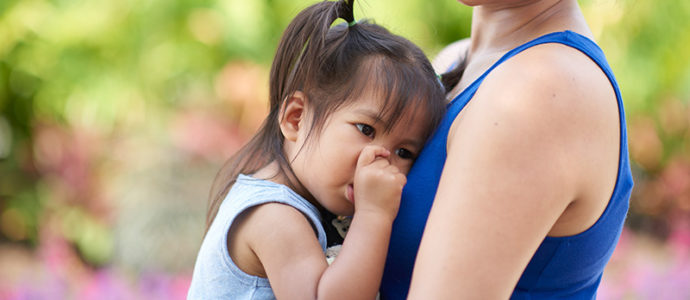Parents often wonder if their kids’ thumb-sucking is a big deal. The short answer is that it really depends. The long answer is that we have to understand all aspects of thumb-sucking and what’s going on in their lives.
Thumb-sucking, or non-nutritive sucking habits, is a natural part of a child’s development. In fact, it’s estimated that 85-90% of kids suck their thumb or fingers at some point in their lives.
The problem with thumb-sucking is that it can lead to an interior open bite. This happens when the top and bottom front teeth don’t touch. It creates a gap, which impacts a child’s ability to swallow. In the worst cases, this can lead to feeding issues.
We look at the following aspects of thumb-sucking to determine if it is problematic and if it needs to be corrected:
5 Aspects of Thumb-Sucking in Kids
1. Age
How old is your child? Most children will stop sucking their thumbs around age 3 or 4. The closer they get to four years old, the changes to the jaw won’t correct itself. Whereas, if a child stops sucking her thumb at age two, the jaw will be more likely to correct itself. Most children will stop when they get into preschool and kindergarten and become aware of the social ramifications. Depending upon the frequency, duration and intensity of the thumb-sucking, they may need treatment to correct the damage if they don’t stop until they are school age. The goal should be to try to get them to stop sucking their thumbs before their grown-up teeth come in.
2. Frequency
How often does your child suck his thumb? Is his thumb always in his mouth? Or is he only doing it at nap and bedtime? The more often he does it, the more likely he is to do damage to his bite.
3. Duration
How long is your child sucking her thumb? If she’s only doing it for 5-10 minutes to fall asleep, it’s unlikely that she’s doing a lot of damage in a small window of time.
4. Intensity
How intensely is your child sucking his thumb? Does it sit loosely in his mouth, or is he actively and intensively sucking? Intensive thumb-sucking is going to cause more damage than doing it loosely.
5. What’s currently going on in his life
To understand the bigger picture, we also have to understand what else is going on in her life. Thumb-sucking is often a coping mechanism for kids. Are there any social stressors? Is she only doing it at her new school? Is she potty-training? Has there been another major stressor in her life, like a death or divorce? We can make recommendations for individualized treatment if we understand why she’s doing it.
Treatment
There are multiple ways to help a child stop sucking his thumb. Families can play in integral role to help make this happen. Incorporating reminders into your day is one way to accomplish this. Remind them that this is the next step in getting older; it’s not a punishment. Say things like, “Only big kids can stay up and watch the movie tonight. You’ll need to stop sucking your thumb if you want to see it.”
There are also dental appliances that can be utilized. We can insert a roller on the palate of their mouths, to encourage them to play with the roller rather than suck their thumb. It’s essentially distraction therapy. It also reduces the satisfaction they get from sucking their thumb because they can’t close their mouth around it. In order for this method to be successful, though, a child needs to be mentally prepared to stop.
There is no one-size-fits-all way to help a child stop thumb-sucking. We have to look at the many features of the act, as well as what else is going on in her life, to truly make an impact. If you have concerns about your child’s thumb-sucking, please speak with her dentist.
To learn more about pediatric dentistry at Cincinnati Children’s, please visit our website or call 513-636-4641.







I have 4 children who are all in their 40’s now. My oldest and youngest, a boy and a girl, were literally born sucking their thumb. My son switched to a pacifier when he could grasp it and put it in his mouth.
My daughter never did. She sucked her left thumb constantly – until it was about 1/3 smaller than her right thumb. We didn’t know anything about autism. In retrospect I believe both of these children were autistic to a mid level and they used thumbsucking to withdraw from interaction with others. The difficulties they have faced as teens and adults in relationships and behavior have impacted their life experences very negatively. Having done all I could do during their lives to help them, the other members of my family have been impacted negatively as well. This possibility is an important one for parents and doctors, I believe, to explore.